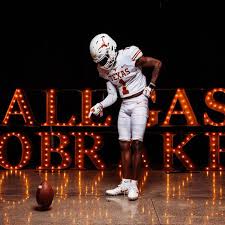
On February 24, 2007, two top high school quarterback recruits waited outside Mack Brown’s office to find out if they had received a coveted scholarship offer from the Texas Longhorns.
Riley Dodge, a gunslinger from perennial Texas prep school Southlake Carroll High, waited impatiently. A Houston-area multi-sport star with a golden arm and NFL pedigree sat on a nearby couch. His name is Andrew Luck.

Brown, Texas’ stately head coach who had just guided the Longhorns to a national championship 13 months prior, called the Dodgers first.
The area they entered had two burnt-orange couches facing a coffee table topped with numerous trophies, including a Heisman. The area was filled with game balls, helmets, championship rings, and other keepsakes, as well as photographs on every wall. “It was like a damn museum,” exclaimed former Texas defensive line coach Oscar Giles.
Prior to the advent of year-round recruiting, lavish photo sessions, and multiple unofficial trips, meeting a national championship head coach in February on Texas’ junior day was a privilege reserved for a select few recruits. Dodge, who grew up with burnt orange hanging across his walls, took it all in.
When Brown coached at North Carolina in the 1990s, he discovered that Big Ten programs were providing excellent local prospects before the Tar Heels.
“John Cooper and Joe Paterno were getting all the in-state players wrapped up in Ohio and Pennsylvania early, and then they would be able to go recruit nationally,” Brown told the audience. “All the coaches were saying, ‘Penn State’s offered, Ohio State’s offered, but you didn’t offer.'”So Brown began her junior year at UNC. When he arrived in Texas in 1998, recruiting was slow. Junior years were uncommon, and the majority of scholarship offers went to seniors.
Several programs held junior days in the early 2000s, including LSU, Miami, Ohio State, and Texas A&M. They functioned as early open houses for the upcoming recruiting class, which consisted of second-semester juniors who would become seniors in the fall.
Brown organized his first junior day at Texas in 2004. When the Longhorns played their spring game weeks later, they had one verbal commitment from the ’05 class. The second junior day, following a Rose Bowl victory over Michigan, was more beneficial. Following the 2005 spring game, Texas hadThe junior days comprised the usual unofficial visit fare: a campus tour, a walk through the team facilities, discussions with coaches, a question-and-answer session with Texas players, and, of course, a face-to-face with Brown.
However, the invitation was the draw. Following in-person evaluations from the previous summer’s camp circuit and an examination of junior season film, UT coaches narrowed in on who they thought were the state’s top prospects. Those—and only those—were summoned to Forty Acres. In talent-rich Texas, “It was a who’s who of recruits,” Morris stated.
Leave a Reply